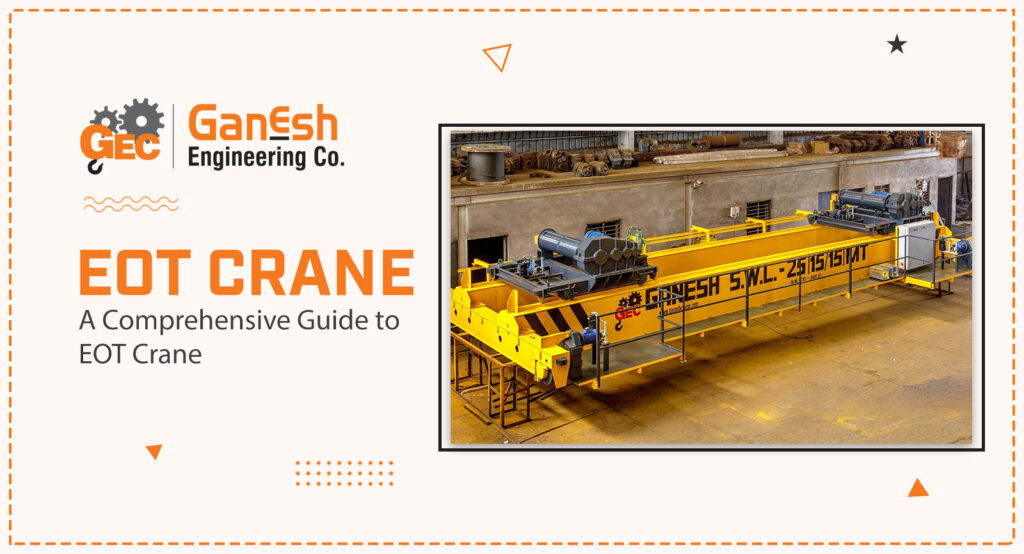
Electric Overhead Traveling (EOT) cranes are the workhorses of countless industries. These versatile machines elevate and maneuver heavy loads across workshops, factories, and warehouses. If you’re looking to streamline your material handling operations, understanding EOT cranes is a crucial first step. This comprehensive guide contains all the information about Electric Overhead Traveling Cranes – from their basic functionalities to the different types and vital safety considerations.
What is an EOT Crane: A Basic Overview!
At its core, an EOT crane consists of a bridge structure that spans an area. This bridge travels along a runway beam system installed on the building’s ceiling or support structures. The bridge carries a hoist unit, which raises and lowers loads, and a trolley that allows the hoist to move horizontally along the bridge beam. Electric Overhead Traveling Cranes are powered by electricity, enabling smooth and precise control over load movement.
Types of EOT Cranes: Choosing the Right Fit
Electric Overhead Traveling Cranes come in various configurations to cater to diverse needs. Here’s a breakdown of the two main classifications:
Girder Configuration:
- Single-girder cranes: Ideal for lighter loads (up to 20 tons) and shorter spans. These types of EOT cranes are cost-effective and quicker to install.
- Double-girder cranes: Designed for heavier loads (up to hundreds of tons) and longer spans. They offer superior stability and rigidity.
Running Configuration:
- Top-running cranes: The bridge beam travels on top of the runway beam. This design allows for maximum lifting height and is suitable for a wide range of applications.
- Under-running cranes: The bridge beam travels on the underside of the runway beam. This is a space-saving option and is often used for lower-profile applications with lighter loads.
Specialized Electric Overhead Traveling Cranes
The world of EOT cranes extends beyond these basic configurations. Here are some specialized types designed for specific tasks:
- Grab bucket cranes: Equipped with a grabbing attachment to handle loose materials like sand, gravel, or scrap metal.
- Mag cranes: Utilize magnets to lift and move ferrous materials efficiently.
- Vacuum cranes: Employ suction to lift and transport non-porous materials like glass or sheet metal.
Selecting the Right EOT Crane: A Crucial Decision
Choosing the right Electric Overhead Traveling Crane for your needs requires careful consideration of several factors:
- Lifting capacity: Determine the maximum weight you need to lift.
- Span length: Measure the distance the crane needs to cover horizontally.
- Lifting height: Identify the required vertical clearance for load movement.
- Duty cycle: Evaluate how frequently the crane will be used and the intensity of each operation.
- Facility layout: Assess the available space and structural limitations.
Consulting with a reputable EOT crane supplier is vital to ensure you select the right equipment for your specific needs and workplace environment.
Safety Considerations For EOT Cranes
Electric Overhead Traveling Cranes are powerful tools, and safety is paramount. Here are some key safety considerations:
- Regular maintenance: Conduct thorough inspections and preventive maintenance to ensure the crane is in optimal working order.
- Qualified operators: Only trained and certified personnel should operate the EOT crane.
- Pre-lift checks: Prior to each operation, perform a visual inspection of the crane, lifting slings, and the load itself.
- Load capacity limits: Never exceed the crane’s rated lifting capacity.
- Clear communication: Ensure clear communication between the crane operator, spotters (if applicable), and personnel in the vicinity.
- Personal Protective Equipment (PPE): Operators and anyone near the crane operation zone must wear appropriate PPE.
Following these safety protocols will help prevent accidents and ensure the smooth and safe operation of your EOT crane.
Conclusion:
Electric Overhead Traveling Crane are a valuable asset for any industry that requires efficient and safe material handling. By understanding the different types, configurations, and crucial safety considerations, you can leverage the power of these cranes to optimize your operations and achieve greater productivity. Remember, consulting with a qualified EOT crane supplier is essential to find the perfect fit for your specific needs and ensure a safe and efficient work environment.

